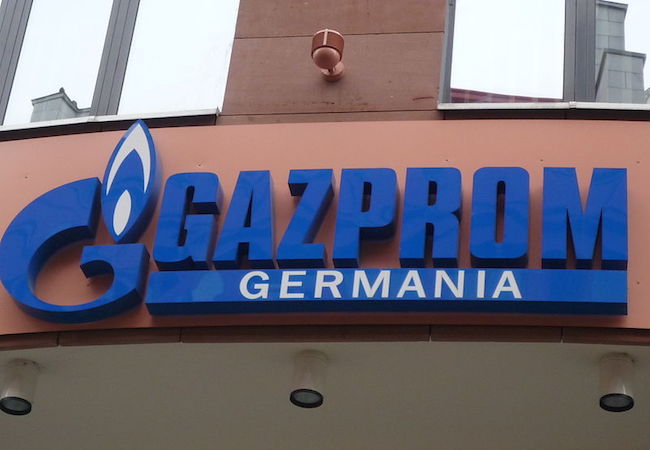
By Raphael Benaroya
Russia’s global aggression has included both overt and covert acts—most notably military interventions in Ukraine and Syria, influence peddling in Venezuela, and election meddling throughout the West. But the threat posed by Russian control over energy is just as significant—and growing. Russia is seeking to expand its energy influence in China, India and, especially, Europe. In my interactions with European and U.S. government officials, it has become clear that Russian energy is an increasingly critical issue for European autonomy and security, as well as for the strategic global interests of the United States.
More than a dozen U.S. allies in Europe rely on Russian gas for at least 75% of their energy. Gazprom, the Kremlin-backed energy giant, commands more than a third of Europe’s gas imports. Industry leaders expect Russia to export a record 200 billion cubic meters of gas this year and in the short term, Russia’s energy leverage is likely to grow even more. Europe’s domestic gas output is expected to fall in the coming years, while demand rises, and Russia is moving to fill the gap with new pipelines through the Baltic and Black Seas.
These pipeline projects serve Russia not only for commercial gain, but also as geopolitical tools to assert influence and foment divisiveness in the West. Russia’sgoals for the new pipelines includebypassing Ukraine as an energy conduit—Ukraine funnels almost half of Russia’s fuel exports to Europe today—and driving wedges between the U.S. and its allies by striking energy deals with individual European countries, like Germany.
The Nord Stream 2 (NS2) pipeline being built under the Baltic Sea will double the capacity of Russian gas flow directly to Germany, Europe’s largest gas consumer. Other European countries, like Poland, fear that this German-Russian alliance will erode European unity and tilt the European energy market toward monopoly. The Poles are especially sensitive, with a collective memory of how the country was ravaged during and after World War II, first by the Germans, then by Russia. It is discomforting to Poles, to say the least, to consider a future in which Russia controls one end of the energy spigot and Germany the other.
The U.S government is firmly unified against the NS2 pipeline. A bipartisan letter from thirty-nine U.S. Senators urged the Trump administration to do everything in its power to stop NS2 because it “will make American allies and partners in Europe more susceptible [to] Moscow’s coercion.” Former Secretary of State Rex Tillerson criticized NS2 as a Russian “political tool,” while Secretary of Energy Rick Perry called it a “political gambit” to give Russia more leverage over Europe. The Department of Energy also points out that NS2 as noncompliant with the European Union’s “Third Energy Package,” designed to create a more open, competitive energy market in the EU. Echoing these concerns at a recent security conference in Warsaw, Georgette Mosbacher, the U.S. Ambassador to Poland, warned that NS2 will “deepen European dependence on Russia at a time when we should be moving as fast as possible in the other direction,” reflecting President Trump’s assertion that Germany’s energy policy could make it “captive to Russia.”
The danger of European dependence on Russian energy has already been made clear—when Russia cut gas supplies to parts of Eastern Europe in 2003, 2006, 2007, 2009 and 2014. In the latter instance, Moscow slowed gas deliveries to Poland and cut off supplies to Ukraine entirely, in a thinly-veiled effort to coerce acceptance of Russia’s annexation of Crimea. If the NS2 pipeline enables Moscow to bypass Eastern Europe as a gas conduit to Western Europe, how hard will the West be willing to push back against Russia the next time it cuts off Ukraine, Poland, Belarus, Georgia, or the Baltic States? As the coalition of U.S. Senators stated in their bipartisan letter, NS2 would “remove one of the biggest reasons for Russia to avoid large-scale conflict in Eastern Ukraine.”
If these European concerns seem distant to the U.S., consider how Russia has extended its influence to Venezuela—which is about the same flight time to Miami as Chicago is. Venezuela controls the world’s largest oil reserves, yet relies on Russia and its government-controlled petroleum conglomerate, Rosneft, for financial aid—more than $17 billion since 2006. Russia also has a significant direct stake in at least five Venezuelan oil fields. No doubt Mr. Putin values this leverage for its potential to manipulate the flow and pricing of oil to serve Russia’s global interests.
The good news is that energy represents a vulnerability of Russia as well as a strength. While Russia is the world’s top oil exporter and second-biggest gas producer (after the U.S.), with the planet’s largest gas reserves, it is overly dependent on petroleum. Energy accounts for some 30% of Russia’s GDP and 50%-60% of the state’s budget.
At the same time, Russia’s overall economy is remarkably weak. Total GDP is about $1.5 trillion (roughly the same as the Netherlands, Belgium and Luxembourg combined). And per capita GDP is under $11,000 (one-fourth of that of Israel, and lagging behind economic “powerhouses” like Costa Rica, Palau and Seychelles). Another sign of Russia’s economic weakness: its military budget and R&D spending are approximately 10% and 2%, respectively, of that of the U.S. And despite its cyber hacking talent, Russia lags far behind the world’s industrial economies in producing quality technology products, like computers, phones and automobiles. After energy, Moscow simply does not have many other sectors to fall back on.
Russia’s efforts to use energy as a strategic lever should serve notice to the West: now is the time to leverage energy policy—not just a traditional military defense—to rein in Russia’s ambitions.
Poland serves as a paradigm of this way of thinking and acting. It has stepped up on both fronts—military and energy—to align itself strongly with the long-term goals of both the EU and U.S.
This year marks the 20th anniversary of Poland joining NATO. The country is one of only a few NATO members to have already met its commitment to spend 2% of gross domestic product on military security. And it is taking on responsibilities to become the center of military operations on NATO’s eastern flank, opposite Russia. For example, Poland has committed to work with the U.S. on improving intelligence-sharing, collaborating against cyber-attacks and expanding joint military exercises. In fact, Polish leaders have called for the U.S. to build a permanent military base in Poland, shifting Europe’s defenses east from Germany.
Poland is also a leader in efforts to shed dependency on Russian gas and limit Germany’s role as Europe’s fulcrum of energy distribution and pricing. The Poles are taking active measures within the EU to diversify energy sources and moveenergy policy decision-making away from Berlin, to Brussels. For example, Poland has built the Baltic’s only land-based liquefied natural gas (LNG) terminal to import gas from non-EU sources—including the U.S. It is also developing an undersea gas pipeline with Norway. In addition, Poland is a leader of the “Three Seas Initiative,” a coalition of twelve countries neighboring the Baltic, Adriatic and Black Seas seeking to increase intra-European economic cooperation, especially on energy. The U.S. Department of Energy is backing the Three Seas Initiative with a program called “Partnership for Transatlantic Energy Cooperation,” aiming to “catalyze investment in critical [energy] infrastructure” in Europe and increase the global strategic role of U.S. LNG.
Poland’s forward thinking and alignment with U.S. interests have earned it the full support of the U.S. government. Poland’s President Duda met with President Trump last fall to establish a “U.S.-Poland Strategic Dialogue on Energy.” They reaffirmed a mutual commitment to promote democratic principles in Europe, strengthen the two countries’ strategic partnership on energy, and thwart Russian coercion.
Following up on that commitment, Poland signed three separate agreements with the U.S. to import billions of cubic meters of American LNG annually over the next two decades. This should enable Poland to shift a significant portion of its energy imports away from Russia, cost-effectively. Poland is also exploring how U.S. nuclear technology can improve its energy diversity and security.
The rest of Europe should look at Poland as a role model for diversifying energy sources and fighting against Russia’s energy hegemony. And, like Poland, other European nations should look to the U.S. as an allied source of energy—to bolster the continent’s economic strength and reduce its dependence on Russian energy. Energy security IS national security—for Europe as a whole, as well as for each country individually.As both the most important asset in Russia’s economy and the lubricant for its external aggression, energy must continue to be a prime focus in the West’s actions toward Russia. U.S. sanctions have deepened the problems of Russia’s ailing economy, but seemingly not enough to dissuade Moscow from following its playbook on destabilizing Western society. To ensure Russia does not encroach on European nations as it has on Ukraine—and to blunt Russian influence in Syria, Venezuela and elsewhere around the world—the West needs to formulate a cohesive energy policy and use it as both a carrot and a stick in dealing with Russia. As the bipartisan group of U.S. Senators wrote, the “best way to guarantee Europe’s long term economic health and independence is to enable…a variety of energy sources, suppliers, and routes” to force Russia to “negotiate as a market actor and not a monopolist.”
Raphael Benaroya is an American businessman, currently the Senior Partner of Biltmore Capital. He serves as Vice Chairman and executive committee member of Business Executives for National Security (BENS), a Washington, D.C.-based, non-partisan NGO. In that role he has received numerous awards for his work on national security.




